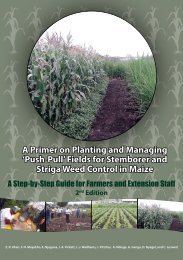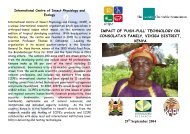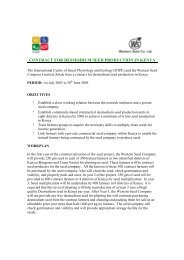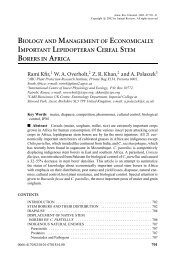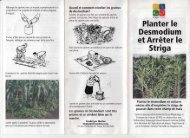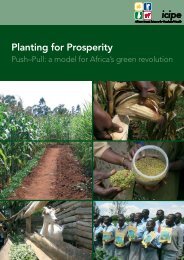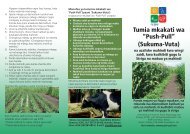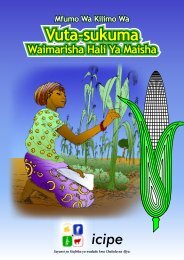The Royal Society Report - Push-Pull
The Royal Society Report - Push-Pull
The Royal Society Report - Push-Pull
You also want an ePaper? Increase the reach of your titles
YUMPU automatically turns print PDFs into web optimized ePapers that Google loves.
or supplements are not available, both genetic and nongenetic<br />
approaches can be used to enhance the nutritional<br />
content of a stable crop and avoid ‘hidden hunger’ due to<br />
shortage of micronutrients. <strong>The</strong> preferred strategy to<br />
eliminate hidden hunger will always involve strategies to<br />
increase the diversity of diet with increased access to fruit<br />
and vegetables. However, in regions where the lack of<br />
infrastructure or other factors prevents diversification of<br />
the diet, the introduction of biofortified varieties may<br />
provide a good short-term solution. <strong>The</strong> advantage of a<br />
biofortification approach is that it capitalises on a regular<br />
intake of a staple food that will be consumed over a long<br />
period even in the absence of international development<br />
agencies. <strong>The</strong> requirement for a one-off investment to<br />
develop the appropriate seeds is also a consideration<br />
(Nestel et al. 2006). <strong>The</strong> importance of nutritional content<br />
and the dietary contribution of food crops to achieve<br />
nutritional security, especially vitamin A, zinc and iron, is<br />
widely recognised (Copenhagen Consensus 2008).<br />
However, the importance of palatability to the consumer<br />
must not be ignored. Nutritional quality can also be<br />
enhanced by the removal of toxic components through<br />
crop management and by genetic enhancement.<br />
3.3.6.1 Crop management to enhance nutritional quality<br />
<strong>The</strong>re are several methods by which the nutritional content<br />
of the harvested crop can be improved through targeted<br />
management and particularly by the use of fertilisers<br />
containing trace elements. <strong>The</strong>se include production<br />
systems to improve grain quality and nutritional value. <strong>The</strong>re<br />
has been an increased focus on agronomic biofortification<br />
within the international fertiliser industry (White & Broadley<br />
2005; Bruulsema et al. 2008). Whole crop management<br />
systems exist to improve quality, health and nutrition, for<br />
instance in cassava (Nassar 2006). However, the full<br />
potential of these approaches requires further research into<br />
the processes through which the nutrient content of crops<br />
can be influenced by fertiliser applications.<br />
Mild drought stresses have been shown to result in<br />
enhanced flavour and aroma in some food crops (Santos<br />
et al. 2007) in addition to enhanced concentration of health<br />
related metabolites (such as ascorbic acid and other<br />
antioxidants).<br />
3.3.6.2 Genetic improvement of crops to enhance nutritional<br />
quality in regions with diet deficiency<br />
Golden rice is a transgenic line that could help to combat<br />
vitamin A deficiency (Dawe et al. 2002). <strong>The</strong> first<br />
generation of Golden rice varieties contained only low<br />
levels of b-carotene and there was some scepticism as to<br />
whether their introduction would mitigate vitamin A<br />
deficiency and benefit poor, rice-dependent households.<br />
However, there are now lines with much higher levels of<br />
b-carotene (Paine et al. 2005) and good evidence from<br />
clinical trials that it is an effective source of vitamin A<br />
(Tang et al. 2009).<br />
A trial of orange-fleshed sweet potato in Mozambique also<br />
illustrates how vitamin A deficiency can be mitigated by<br />
supplies of biofortified staple crops (see Case study 3.7).<br />
Genetic improvement of cassava can enhance nutritional<br />
quality (protein, carotenoids and minerals) using wild<br />
relatives. 7 <strong>The</strong> HarvestPlus programme (see also Case study<br />
3.7) is working to improve the nutritional quality of maize<br />
and rice. Recently, rice plants have been engineered with<br />
elevated iron levels in the rice kernels (Wirth et al. 2009).<br />
Case study 3.7. Biofortification of orange-fleshed sweet potatoes for combating vitamin A deficiency<br />
Vitamin A deficiency<br />
Vitamin A is needed for good eyesight, and extreme deficiency leads to blindness. It is estimated that worldwide,<br />
250,000 preschool children go blind due to vitamin A deficiency every year (Bouis 2008). One method of combating<br />
micronutrient deficiency is through the use of supplements or fortified foods. However, this is not an option for the rural<br />
poor, who may live too far from the nearest market and cannot afford to buy these products. An alternative method of<br />
enhancing Vitamin A in the diet is through biofortification. This involves breeding staple crops which have high levels of<br />
micronutrients.<br />
How is it done<br />
<strong>The</strong> micronutrient content of staple foods can be increased through conventional breeding where adequate germplasm<br />
variation is available. <strong>The</strong> HarvestPlus programme is working towards producing sweet potato lines with high levels of<br />
the vitamin A precursor b-carotene. <strong>The</strong> target level of b-carotene depends on the levels available to the consumer<br />
following cooking and digestion, and whether the sweet potato will be the sole source of vitamin A in the diet. Studies<br />
have shown that feeding b-carotene-rich sweet potato to school children increases their vitamin A stores in the liver<br />
(van Jaarsveld et al. 2005). Orange-fleshed sweet potato lines with high levels of the vitamin A precursor b-carotene<br />
have been identified.<br />
Micronutrient-dense traits are generally stable across all environments, which makes it easier to share germplasm<br />
internationally. Furthermore, micronutrient traits can be combined with traits for high yield.<br />
7 ‘Decades of cassava research bear fruit.’ Available online at: http://<br />
www.idrc.ca/en/ev-5615-201-1-DO_TOPIC.html.<br />
36 I October 2009 I Reaping the Benefits <strong>The</strong> <strong>Royal</strong> <strong>Society</strong>



